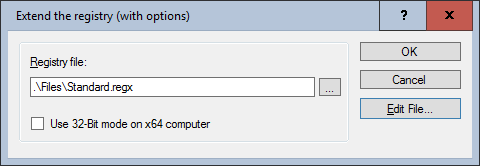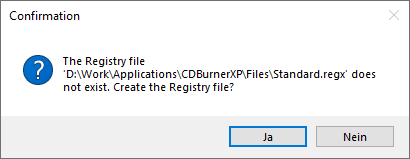Registry
Registry
The Packaging PowerBench contains - as you know it from the Packaging Workbench in DSM - a registry editor that allows you to graphically edit .reg- and .regx files.
|
Note: The .regx file format is an XML-based proprietary file format used for registry extensions. It is used when converting .nir files from DSM because they contain more information (e.g. variables) than is possible in standard .reg files. You can also manually create and edit .regx files, which can then also contain extended information. |
For example, to insert a new registry extension into your script, drag the Import-Registry command (or one of the DSM aliases RegLoad or RegLoadEx) into the script window. In the dialog, enter the path (manually) to the .reg- or .regx-file and press the "Edit File..." button:

|
Note: As known from DSM, you can use the relative path ".\" to reference the package directory. |
You will be asked if you want to create the registration file, which you can answer with "Yes".

The integrated registry editor opens and you can create, delete, edit keys and values as usual.

You can also specify in the context menu for keys that they should be edited in the 32-bit section of the registry ("Use 32-Bit Mode"), that values in this key should be written again when the package is executed in Repair mode ("Restore values during Repair"), and that values in this key should be removed again on uninstallation ("Remove values during Uninstall"). If you set one of these properties on a key that has subkeys, you will be asked whether the setting should also be inherited by subkeys.
When you have finished editing, save your changes (a * next to the file name indicates that changes have been made to the file) and close the registry editor window.